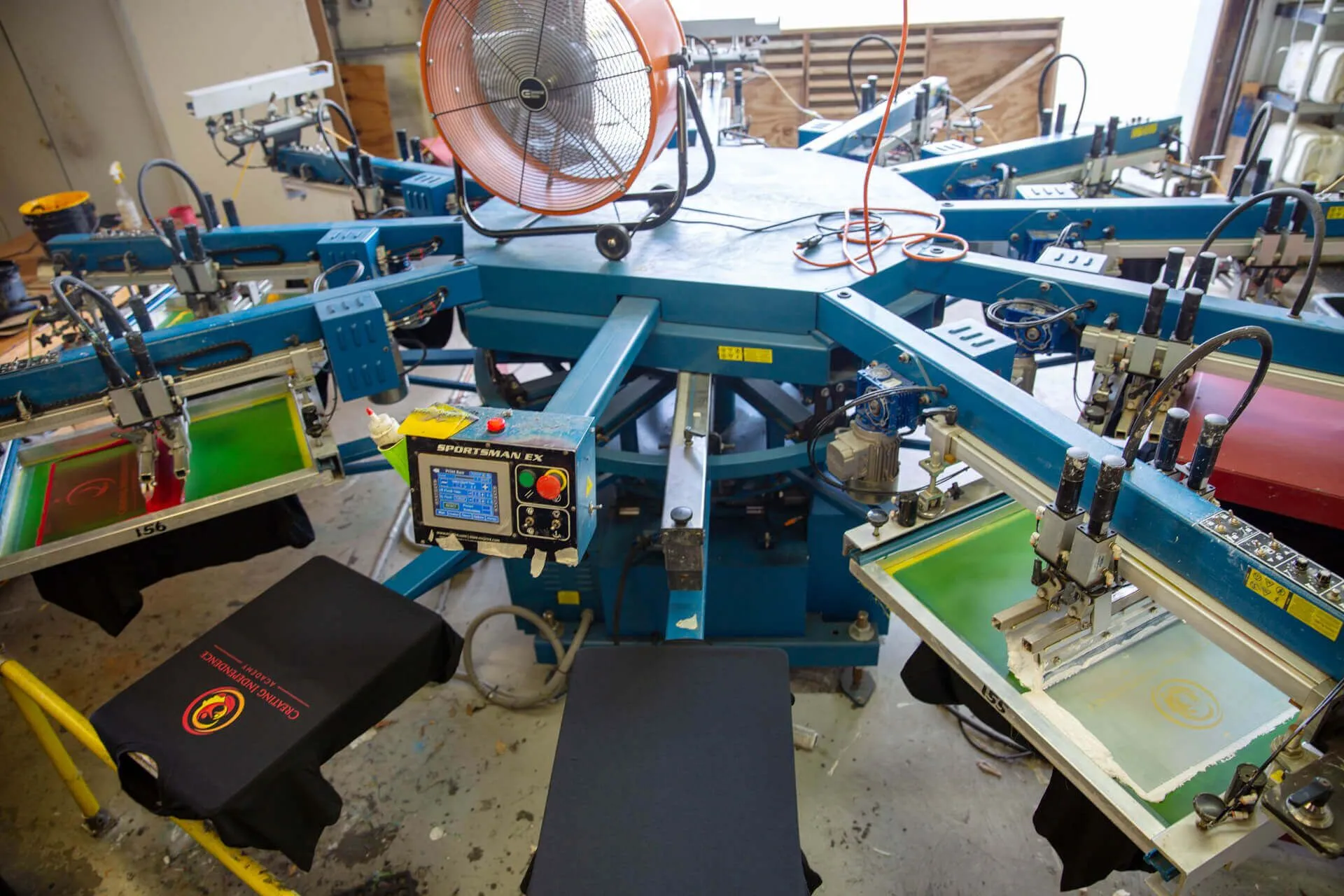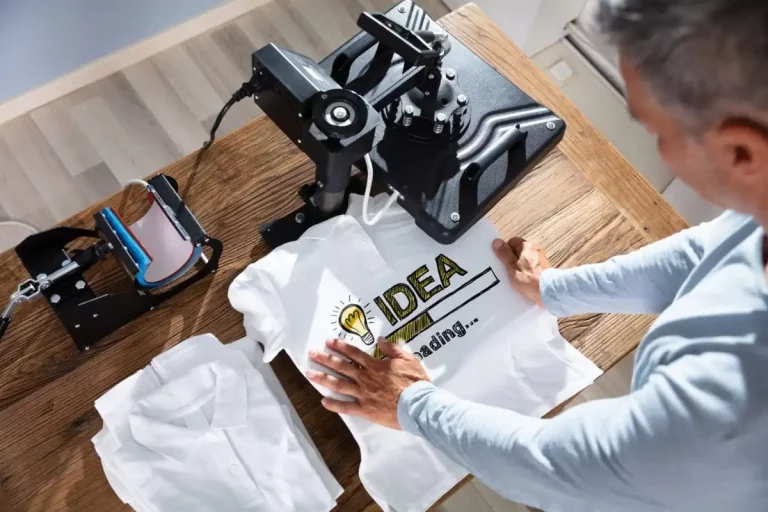Fast Turnaround Custom Screen Printing for Events
Fast Turnaround Custom Screen Printing for Events
Blog Article
Display Printing Uncovered: Every Little Thing You Need to Learn About T-Shirt and Garment Printing Techniques
If you have actually ever before asked yourself just how those vibrant styles finish up on your favorite t-shirts, you're in the right location. Screen printing is a remarkable method that integrates art with strategy, using limitless possibilities for imagination. Recognizing the fundamentals, from devices to ink options, can greatly affect your results. Ready to discover the essential aspects that make display publishing an art form? Let's discover the details that can raise your projects.
The Essentials of Screen Printing: Just How It Functions
When you dive into display printing, you'll uncover it's both a scientific research and an art. At its core, display printing involves developing a pattern, or display, that enables ink to pass with only in details areas (screen printing kit). You start by choosing your style and preparing your screen with a light-sensitive solution. When you expose this solution to light, it sets, leaving your style as a negative room.
Setting the screen over the fabric, then utilize a squeegee to press ink via the display onto the garment. Each step is crucial, and understanding them will certainly elevate your screen printing abilities, transforming basic garments right into unique, meaningful pieces.
Kinds Of Screen Printing Techniques
As soon as you grasp the basics of display printing, it's time to explore the different strategies that can raise your layouts. One prominent approach is standard screen printing, where ink is pushed with a stenciled display. This technique is great for vibrant, lively shades. Then there's water-based ink printing, which offers a softer feel and is environmentally friendly, but it requires a various method to curing.
An additional choice is plastisol printing, understood for its sturdiness and vibrant colors, making it a favored for numerous brand names. Experiment with halftone printing to create slope effects and intricate designs.
Essential Equipment for Screen Printing
To attain stunning results in display printing, having the best tools is essential. You'll need a durable display printing frame, which holds the mesh that moves your design onto the garment. Next off, invest in premium squeegees; these are crucial for applying ink uniformly throughout the screen.
Choosing the Right Inks and Materials
When choosing inks and materials for screen printing, you require to consider the kind of ink that works finest for your project. Assume regarding material compatibility to ensure your layouts look excellent and last lengthy. Explore eco-friendly ink alternatives to make your printing procedure extra sustainable.
Types of Screen Inks
Picking the best display ink is vital for achieving dynamic, sturdy prints that fulfill your project's demands. There are numerous kinds of screen inks to analyze. Plastisol ink is popular for its flexibility and ease of usage, providing excellent shade opacity on dark materials. Water-based ink, on the other hand, supplies a softer feel and is environmentally friendly, making it ideal for those wanting to minimize their ecological effect. Release inks get rid of dye from the material, leading to a soft, vintage appearance but call for specific handling. Specialty inks, such as glow-in-the-dark or metallic, can include distinct effects to your styles. Review your task needs and select the ink that straightens ideal with your wanted end result.

Textile Compatibility Considerations
Comprehending textile compatibility is vital for attaining premium screen prints, particularly since different products react distinctively to different inks. Constantly test your inks on sample textile to guarantee they adhere appropriately and preserve shade integrity. Additionally, keep in mind that fabric weight and appearance can affect the last outcome, so choosing the best ink and product combination is important for your task's success.
Eco-Friendly Ink Options
Environment-friendly inks are coming to be a popular option for display printers that want to reduce their environmental effect while keeping quality. When choosing inks, consider water-based inks, which are less dangerous and simpler to cleanse up contrasted to conventional solvents.
In addition, seek inks made from renewable energies, such as soy or vegetable-based options. By choosing the appropriate inks and products, you'll not just produce sensational designs however also add to a more sustainable printing process. Make the button, and your prints will mirror your commitment to the setting!
Preparing Your Style for Screen Printing

File Format Requirements
To assure your style looks vivid and sharp on textile, you'll require to pay close attention to file format needs for display printing. Make certain your design has a transparent history to avoid undesirable white sides on your prints. Maintain color settings in mind; CMYK is basic for screen printing, so transform Full Report your RGB designs as necessary.
Shade Separation Strategies
Color splitting up is a vital step in preparing your design for display printing, and understanding it can significantly enhance your print high quality. You'll need to break your layout into individual shades, as each shade requires a different display during printing. Begin by recognizing all the colors in your style and produce layers for each one. You can make use of software application like Adobe Photoshop or Illustrator to isolate and separate colors properly. Be particular to conserve each layer as a separate file, generally in a style like TIFF or PSD. This accuracy not just assures accurate color representation but also improves the printing procedure. By focusing on shade separation, you'll achieve vibrant and specialist outcomes in your screen-printed garments.
Resolution and Size
Attaining the most effective lead to display printing begins with guaranteeing your layout has the appropriate resolution and size. Ideally, your artwork should go to least 300 DPI (dots per inch) for sharp, clear prints. Your last item could look pixelated and less than professional. if you utilize reduced resolution.
When it concerns size, think about the measurements of your print location. Design your art work to match the final print dimension, website here ideally creating it in the actual measurements you'll be publishing. This way, you'll prevent any kind of unexpected scaling problems.
Constantly check your layout in both vector and raster formats. Vector graphics can be scaled without losing quality, making them perfect for display printing. Preparing appropriately will ensure your design looks fantastic on every garment!
Step-by-Step Display Printing Refine
Display printing is a vibrant procedure that permits you to develop lively designs on numerous surface areas. To get going, you'll require a display, emulsion, and your chosen ink. First, prepare your screen by cleansing it completely. Next, apply the solution equally and let it completely dry in a dark location. When completely dry, subject your screen to light with your design put on it, which will set the solution where the light hits, creating a pattern - screen printing kit.
After washing out the unexposed emulsion, your screen is all set. Establish it up on your printing surface and straighten your garment under it. Pour ink onto the display and use a squeegee to push the ink via the stencil onto the material. Raise the screen meticulously and let the print dry. Finally, cure the ink utilizing warm to ensure sturdiness. That's it! You've successfully display published your design.
Tips for Successful Display Printing Projects
While you're diving into your display printing tasks, keep in Recommended Site mind that prep work is key to success. Beginning by collecting all your products-- inks, garments, mops, and displays. A clean workspace aids protect against unwanted mistakes, so clean before you start.
Following, confirm your artwork is high-resolution and correctly sized for your garment. Test your screen for appropriate direct exposure and tidy it extensively to avoid smudges. When blending your inks, adhere to the producer's standards to accomplish the right uniformity.
During printing, use also pressure with your squeegee for regular results. Don't rush; take your time to verify each print satisfies your requirements. After printing, let your garments completely dry totally before dealing with or packaging them.
Last but not least, constantly maintain an example of your benefit future referral. By doing this, you can examine your development and improve your techniques in time. Satisfied printing!

Frequently Asked Inquiries
The length of time Does It Require To Set up a Display Printing Job?
Establishing a display printing job usually takes about thirty minutes to an hour. You'll prepare the displays, mix inks, and change journalism. The time varies based on complexity and experience, so remain organized!
Can I Publish on Various Material Keys In Making Use Of the Same Strategy?
Yes, you can print on various material types making use of the same strategy, however you'll need to readjust your inks and settings. Some fabrics soak up ink in different ways, so exploring assurances the most effective results for each material.
What Prevail Errors to Stay Clear Of in Display Printing?
When display printing, avoid typical errors like utilizing the wrong ink, neglecting appropriate exposure times, or missing pre-press checks. Constantly check your setup and maintain tidy displays to assure high quality results each time.
Exactly How Can I Correctly Clean and Maintain My Screen Printing Tools?
To effectively tidy and maintain your display printing equipment, you must frequently wash screens with ideal solvents, examine mops for wear, and assure all devices are kept dry and dust-free. Consistency prevents costly repairs and boosts performance.
Is Display Printing Eco-friendly Contrasted to Other Techniques?
Screen printing can be a lot more eco friendly than other approaches, particularly if you utilize eco-conscious products and water-based inks. By selecting sustainable supplies and methods, you decrease waste and decrease your effect on the planet.
Display Printing Uncovered: Whatever You Need to Know Concerning Tee and Garment Printing Techniques
At its core, display printing includes producing a stencil, or display, that allows ink to pass with just in certain areas. Placement the screen over the material, then use a squeegee to push ink through the screen onto the garment. One popular technique is traditional screen printing, where ink is pressed through a stenciled screen.When choosing inks and materials for screen printing, you require to take into account the type of ink that functions best for your job.
Report this page